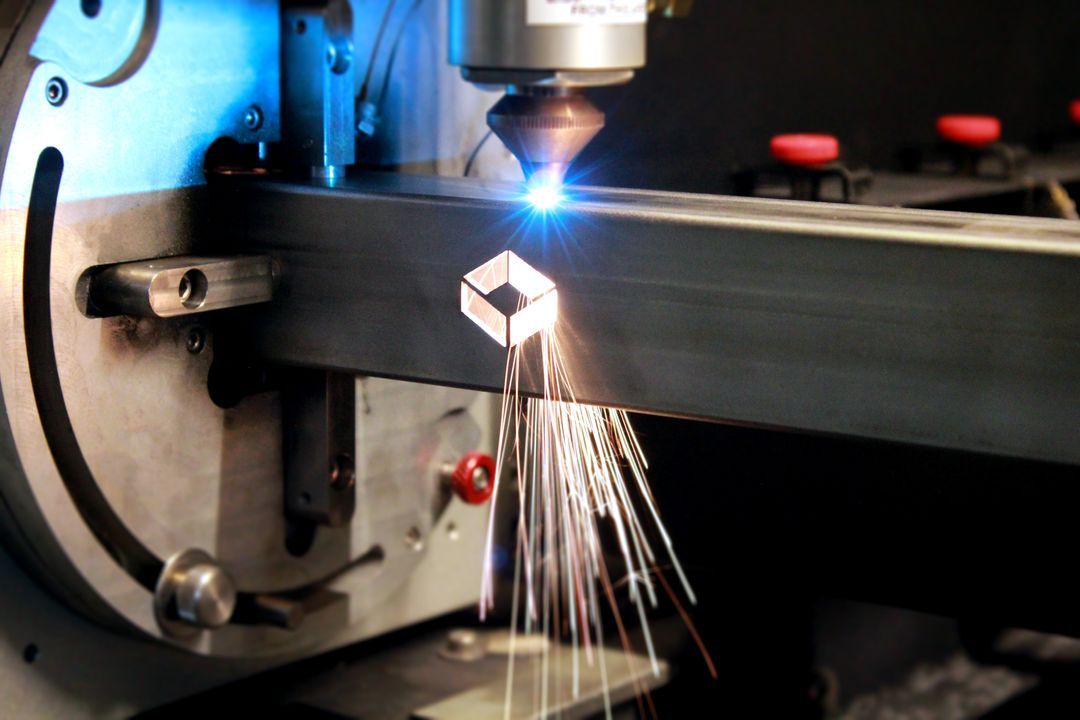Lead Time Update: FabLight systems now ship in 4 weeks! Take advantage of your Section 179 tax deduction today!
Dismiss
If you're in the market for a fiber laser system, there's an aspect of the technology you may not have considered: the role of assist gas. Your choice of assist gas can significantly affect cut quality, the degree of post-processing required, and ultimately the efficiency of your overall operation. This guide will walk you through the basics of assist gases, what they do, and how to choose the right one for your application.
In a fiber laser system, the assist gas plays a key role in the cutting process. Your FabLight machine uses a 'melt-and-blow' technique, where only about a third of the material is directly heated by the laser. The remaining two-thirds are heated up and melted when the assist gas blows the directly heated material past them.
Choosing the right type of assist gas, therefore, depends on the material you're cutting and the quality of cut you're seeking. On a FabLight machine, we typically recommend two types of assist gases:
It's essential to remember that the assist gas needs to be clean and dry. Contaminated air can not only degrade the laser beam power, but it can also damage sensitive components of the machine, including the capacitive height sensor. This can lead to poorer cut quality and potentially harm your machine.
As you set up your assist gas system, you'll need a few key pieces of equipment: an air compressor, filters, and a dryer.
In your journey to optimize your FabLight system, you'll encounter two kinds of compressors – piston and rotary-screw – each with distinct input pressures. With an affordable piston compressor, the pressure might falter during FabLight operation, causing it to drop beneath the necessary process cutting pressure. This can lead to a noticeable deterioration in cut quality, sometimes even preventing successful cuts. Thus, it's advisable to choose a piston compressor that boasts a higher pressure rating than the process requires.
On the other hand, rotary compressors, while able to deliver continuous CFM, might tip your budget scale when it comes to high-pressure ratings. However, if you already have a rotary compressor system that doesn't meet the pressure requirements, there's a cost-effective workaround. Rather than investing in a new system, consider an air-booster to elevate you to the perfect input pressure. This device enables you to capitalize on the rotary compressor's constant CFM while achieving the required pressure levels, thereby ensuring optimal cutting results with your FabLight.
A piston system might suffice for a a prototyping facility with breaks between projects or small batch production. For facilities that plan on doing full 8-hour shift production runs, it's worth investing in a rotary screw system for continuous airflow. The air compressor should also provide appropriate pressure and CFM. You'll need around 10 CFM to ensure you've got enough air to get through any job.
You'll also need filters for coalescing oil and water, and a 5μm particulate filter right before the machine. A non-cycling refrigerated dryer should be used with a FabLight systems. Desiccant systems should be avoided as they typically cannot dry air to the quality a FabLight requires to avoid contamination. It should come with a humidity sensor to detect any failure of the dryer with a display or alarm. Multiple stages of filtering along with a dryer ensures that the air passing through your system is clean and dry before getting to the sensitive components inside your machine.
Proper preventative maintenance is critical to keep your system running smoothly and avoiding damage to your machine. Be sure to follow the manufacturer's requirements.
When choosing the right configuration for your machine, it's important to decide on your goals that we walked through above. Below are the requirements for both the low-pressure (LP) and high-pressure (HP) configurations.
Remember, choosing the right assist gas and compressor setup is as crucial as selecting the right machine. If you need further guidance, our team of FabLight experts is always available to help guide you through the process.
3D FabLight was founded in 2015 with a mission to break down the barriers to advanced flexible manufacturing using lasers and software. Our team has decades' worth of experience designing laser cutters and machine tool software.
With 3D FabLight, you get the best of both worlds. Not only do you receive our remarkable laser cutting technology guaranteed to meet your cutting needs, but you also get access to our team of dedicated professionals. We provide every customer with top-notch service, answering questions and helping them to personalize their needs. In addition, our team is available for software support. To watch a webinar, click here.